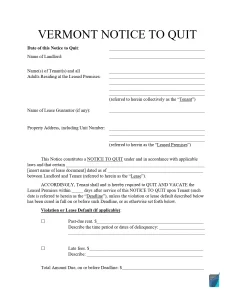Vermont Eviction Notice Forms
The Vermont eviction notice is a form used to inform tenants about possible removal for reasons like unpaid rent, lease violations, or the end of the lease term. This document must clearly explain the cause of the eviction and give a set period of time to either fix the problem or leave the premises.
In Vermont, the length specified in the eviction notice template may differ. For example, failing to pay rent usually requires a 14-day notice, while other breaches of the lease may require a 30-day form. This paperwork initiates the eviction procedure, giving tenants enough time to respond. The form must adhere to Vermont’s rental regulations to be deemed legitimate.

Build Your Document
Answer a few simple questions to make your document in minutes
Save and Print
Save progress and finish on any device, download and print anytime
Sign and Use
Your valid, lawyer-approved document is ready
Vermont Eviction Laws
Under Vermont Statutes, Section 4455, tenants must pay rent on time and at the place agreed upon by both parties. Additionally, rent increases require a 60-day notice if the rental period is to be adjusted accordingly. Evictions in Vermont are primarily governed by Section 4467, which outlines several grounds:
- Rent nonpayment. A landlord can end a rental agreement for unpaid rent by giving the tenant a notice that they have at least 14 days to leave.
- Violation of lease terms. If a tenant breaches any other lease term deemed material, the landlord must provide a 30-day notice to remedy the breach or vacate.
- Illegal Activities. If the tenant engages in criminal behavior, immediate grounds for eviction can be established, with a required 14-day notice period.
- No-cause termination. For month-to-month leases, landlords can terminate the lease with a notice period of 60 days for tenancies under two years and 90 days for those extending beyond two years.
If a tenant corrects the breach of a rental agreement within the notice period, the eviction process may be halted. The Vermont Statutes further dictate specific protocols for issuing such forms and processing eviction actions in court. If the tenant fails to address the cited issues within the notice period, the landlord may initiate an ejectment action by formally filing a complaint in court.
Vermont Eviction Notice Laws Details
| Rent Grace Period | None |
| Notice of Non-Payment | 14 days |
| Notice of Non-Compliance | 30 days |
| State Laws | Vermont Statutes, Title 9, Sections 4455 to 4468 |
Eviction Notice Types Used in Vermont
Property owners in this state can use several types of notices depending on the circumstances surrounding the eviction.
14-Day Notice for Nonpayment of Rent
As detailed in Section 4467(a), landlords must provide at least 14 days’ notice for evictions due to nonpayment of rent. This notice is critical if the tenant does not settle the outstanding rent within the given timeframe.
30-Day Notice for Breach of Rental Agreement
As Section 4467(b) outlines, landlords must provide a 30-day notice for lease term violations unrelated to rent payments. This notice period gives tenants enough time to handle the breach or prepare to leave the property.
Notice for Termination Without Cause
Depending on the length of tenancy and the type of rental agreement, landlords may issue a notice of termination without cause with varying notice periods — from 21 days to 90 days, as delineated in Section 4467(c).

Popular Local Eviction Notice Forms
Eviction Process in Vermont
The eviction process in Vermont is structured to ensure fairness and legal compliance. To vacate tenants, you must follow several steps.
Issuance of Eviction Notice
The eviction process in Vermont begins with the landlord issuing an appropriate eviction notice. If the tenant does not address the issue within the specified time, the landlord can move forward by filing an eviction lawsuit, known as an ejectment action.
Importantly, under Section 4463, landlords are prohibited from forcibly removing tenants, shutting off utilities, or denying access to the property without a proper judicial order.
Filing the Ejectment Action
The process progresses as the landlord files a complaint in the appropriate Vermont court. This complaint details the reasons for eviction and the prior steps taken, such as the notice. This stage sets the groundwork for the judicial review of the eviction.
Court Hearing
Once the complaint is filed, tenants can respond — either contesting the eviction or acknowledging the claims. Hearings are then scheduled, during which both parties can present their cases. Adherence to specific legal statutes, especially those outlined in Section 4467 regarding notice and procedures, is critical for the landlord’s case.
Court Decision and Final Order
The process concludes with the court’s decision. The court will issue an eviction order if the eviction is deemed justified. Notably, under Section 4467(j), landlords are permitted to continue with the eviction even if they accept rent after issuing the notice, provided the reasons are other than nonpayment.

Use our document builder to customize any template on FormsPal to your preferences. Here is a number of some other widely-used Vermont forms we provide.
Other Eviction Notice Forms by State